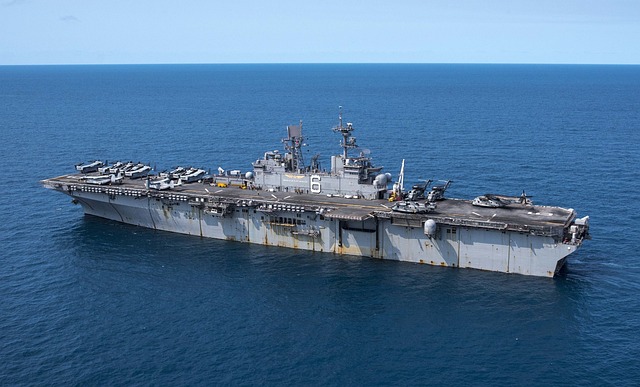Naval battles have shaped the contours of our maps and steered the tides of human history, from ancient triremes to ironclads to aircraft carriers. Today, naval enthusiasts reconstruct these epic tales by pouring over old maps and ship logs, wearing their favorite Navy hat, and collecting treasured memorabilia. These artifacts echo a deep appreciation for the strategy and bravery that defined these monumental clashes.
Choosing the most significant naval battles dives into the heart of history, where the stakes are as vast as the oceans themselves. Each selected battle turned the tide of the wars in which they were fought and showcased the evolution of naval tactics and technology. These confrontations are a testament to human ingenuity and the relentless pursuit of dominance, resonating through history as lessons in strategy and the human spirit.
1. The Battle of Salamis (480 BC)
Our first voyage into history takes us back to 480 BC, to the Strait of Salamis near Athens. Here, the Greek city-states under Themistocles faced the enormous fleet of Xerxes I of Persia. Against overwhelming odds, Themistocles devised a cunning plan to lure the Persian ships into the narrow strait.
The congested waters prevented the Persians from capitalizing on their numbers, turning their advantage into a trap. The smaller, more maneuverable Greek triremes danced around the Persian behemoths, dealing a crushing blow. This battle saved Athens and ensured the survival of Greek culture and its future contributions to Western civilization.
2. The Battle of Trafalgar (1805)
Fast forward to 1805, and we find ourselves off the southwest coast of Spain, near Cape Trafalgar. Here, Admiral Horatio Nelson of the British Royal Navy cemented his legacy. With 27 ships of the line, Nelson faced a larger Franco-Spanish fleet of 33.
His audacious tactics — like dividing his fleet into two columns and driving them perpendicularly into the enemy’s line — broke all conventions. The move caused confusion and disarray among the Franco-Spanish fleet. Nelson’s victory ensured British naval dominance, reshaping European politics for over a century.
3. Battle of Midway (1942)
In June 1942, six months after Pearl Harbor, the U.S. turned the tide of the Pacific War in the dramatic Battle of Midway. This pivotal clash unfolded on a speck in the Pacific, where U.S. intelligence set a trap after cracking Japanese codes.
As Japanese bombs targeted the Midway Atoll, U.S. aircraft carriers awaited their move. In a fierce counterattack, American dive bombers took advantage of distracted Japanese defenses to sink four of Japan’s aircraft carriers — Kaga, Akagi, Soryu, and Hiryu — while only losing the USS Yorktown.
This stunning victory shifted naval power to the Allies and marked a decisive turning point in the Pacific Theater. It showcased the blend of bravery, strategy, and sheer luck that often dictates battle outcomes.
4. Battle of the Philippine Sea (1944)
The wide blue yonder of the Pacific Ocean in 1944 served as the stage for the Battle of the Philippine Sea, one of the largest naval battles during World War II. This battle was a true titan clash, featuring extensive aircraft carrier groups from the United States and Japan.
American pilots called it the “Great Marianas Turkey Shoot” due to the massive losses inflicted on Japanese aircraft. As ships burned and planes fell from the sky, the battle altered the course of World War II in the Pacific and heralded the end of Japanese sea power, paving the way for subsequent American offensives in the region.
Technological Advancements in Naval Warfare
The end of World War II didn’t just close a chapter on traditional naval engagements; it kickstarted a revolution in military technology. The advent of nuclear power introduced submarines that could circle the globe submerged, unseen and unheard until they chose to strike. Stealth technology, cyber warfare, and long-range missiles have shifted the focus from sheer size to invisibility and precision.
These innovations have so drastically altered the naval strategy that today’s commanders operate in a world where satellites and networked systems are as crucial as the ships. In this new age, a fleet’s strength is measured not only by its cannons but also by its ability to deceive and outmaneuver its opponents electronically.
A Storied History and a Bright Future
Standing on the deck of history, gazing back at these monumental naval battles, we witness conflicts of fleets and clashes of human intellect, bravery, and technological prowess. From ancient triremes propelled by rows of rowers to modern destroyers guided by sophisticated radars and computers, these battles illustrate a relentless progression of maritime strategy and technology.
They recount tales of territorial ambitions and heroic stands and remind us of the perpetual human quest to control the seas. This historical journey underscores the crucial role that naval power has played in shaping the political landscapes of nations and empires, reminding us of the profound impact these watery conflicts have had on our world.

fashionabc is a fashion technology platform, comprising a digital directory and various other digital tools and supply chain solutions for the fashion industry ecosystem, that focus on ethical fashion and sustainability. We are building inclusive digital transformation tools for fashion professionals who are willing to take steps towards a more sustainable ethical fashion industry, by adopting AI and DLT blockchain technology.
* building digital profile and IP solutions for fashion businesses
* tackle issues such as provenance and counterfeit in supply chain
* contribute to the construction of a meritocratic ethical fashion industry which is certified and part of the circular economy












